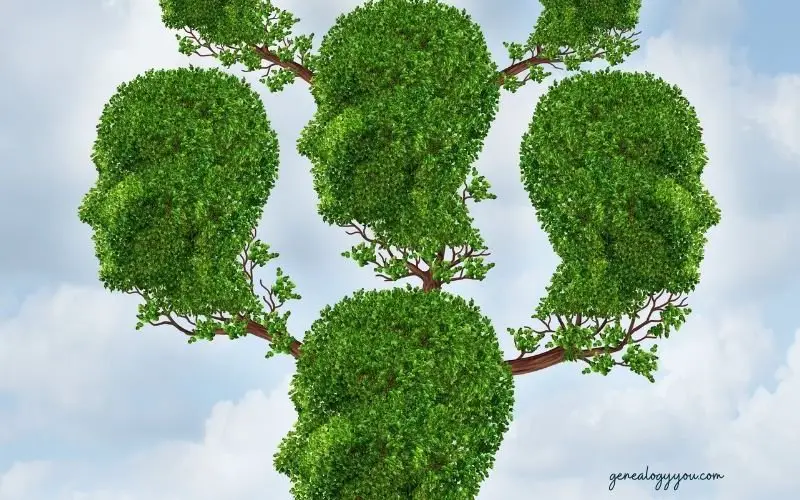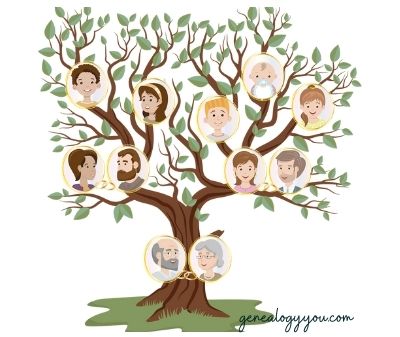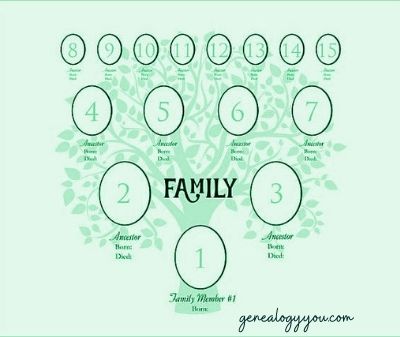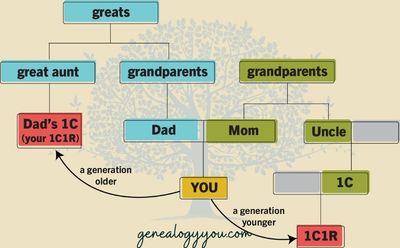Inside: We discuss what degrees mean in genealogy and how you can use this knowledge to decipher your family tree.
A frazzled Aunt Pittypat was using her extensive knowledge of family history to distract herself on Christmas Day from the war that had devastated everyone’s lives.
The union army was making its way to her hometown of Atlanta. As she pours the last of the wine, she recounts the story of how it belonged to her father.
She remembered that he had gotten the beverage from his uncle who was born in Savannah. This uncle married his cousin Jessica from Carrolton, who was his second cousin once removed.

Degrees in Genealogy: What You Need to Know
While Gone With The Wind was a fictional tale with a historical backdrop, it showed on more than one occasion how society used to be much more familiar with genealogy and the extended tree.
As progress has moved us forward, many have forgotten how to determine familial members who are second cousins, fourth cousins, the infamous once or twice removed, and even more distant relationships.
Genealogy as a field wasn’t invented until the early 1800s in the US by John Farmer. Before that, many families kept records as far back as they could.
Due to the fact that people weren’t as mobile as they are today, it was much easier to keep track of third cousins or cousins twice removed.
With the advent of home DNA testing kits, we’re getting a much more in-depth look at our past and just how vast our history really is.
It is not uncommon to uncover secrets of one generation that were swept under the rug. It would have been an impossibility for the truth about a person’s parentage to come up, but new technology enables the truth to come out.
You don’t have to be a professional genealogist to get into the past and figure out how it all works.
If you’re new to the research of common ancestors, looking up a direct ancestor, making a family tree, or just trying to figure out who your cousin’s child is to you, keep reading.
We are going to explain the relationship by degrees and help you become as familiar with the terms as Aunt Pittypat herself.

What does it mean to be related by degrees?
Simply put, a degree represents one step between two people in terms of how they are related to one another. The number of degrees of separation is calculated by adding up the generations it takes to get to each other.
The count starts where the two people have a common ancestor, then goes forward each generation until you get to the same line on the family tree.
Who are the first-degree relationships?
In practice, an easy way to get started is with your immediate family. First-degree relatives have about half of their genes in common with you.
Each direction you move from yourself on a family tree is a step or degree away. An identical twin is in the same spot as you are.
You are one degree from your mother, father, brother, and sister. If you step down to the next branch of the tree to your children, they are also separated by one degree.
Second-degree DNA match
Two degrees is one step out from the inner circle, starting with grandparents. A second-degree circle encapsulates people like your father’s cousin, an uncle.
Also included are aunts, nieces, nephews, and your own grandchildren. This level also pertains to a half-sibling, since you only share 25% of DNA.
Third-degree and First Cousins
First cousins are introduced in the third degree. This level is all about extended family and also includes the greats: great grandfather and mother, great aunts, great uncles, and great-grandchildren.
There are more half relatives here as well, such as half-uncle or half-niece. Typically, at this point, these family members have 12.5% of their genes in common with you.
Fourth-degree

As we go further out, the family gets more extended and crosses over into distant relatives.
Fourth-degree family members are extra greats, including great-great-grandparents and great-great-grandchildren. In this part of the family tree, there is a 6.25% gene commonality.
Fifth-degree and Second Cousins
Second cousins enter into the equation at the fifth-degree tier. A second cousin is someone you share great grandparents with as well as 3.125% of DNA.
This degree also includes a first cousin twice removed, also known as your first cousin’s grandchild.
Once Removed
The term “removed” will refer to a generation separation and what you put in front of it shows the number of generations away. So, a first cousin’s child would be a first cousin, once removed.

Same Ancestor, Once Removed
Now that we understand how to figure out the different degrees between ancestors and relatives, we can figure out how to classify the family correctly. It can be easy to get terms mixed up at first.
For example, a third cousin once removed would be the child of a third cousin. Third cousins are people who share a great-great-grandparent. This cousin is a seventh-degree relative.
Once you get the hang of it, it’s not as complicated as it seems to figure out kinship, families, and parents’ lineage.
Degrees in Genealogy – Frequently Asked Questions
What does 18 degrees mean in genealogy?
Simply put, that means there are 18 steps between two people. After 18 steps, the most likely relationship is being a distant cousin that you have very little shared DNA with but enough to show you are, in fact, related.
However, it should be noted, that it does not necessarily mean that you are related by blood. Steps also include marriage. An individual may be on your family tree but not be a blood relation.
What are degrees in a family tree?
A degree could easily be represented by a branch, each branch is one degree. When your grandparents branch off to your father or mother, that is one degree.
When your parents branch off to you and your siblings, that’s another degree. Between you and your grandparents, that would be two degrees.
You can use branches to help calculate degrees. The more closely related, the fewer branches on the family tree.
What does it mean to be 22 degrees from someone?
If you are 22 degrees from someone on your family tree, that means you are 22 steps from that person. This would be considered a distant relative that you shared far back common ancestors.
What does it mean to be related by degrees?
A degree pertains to one generation. A higher degree means you have less shared DNA but still have common ancestors and a genetic relationship.
Each degree is a step between two individuals who may have a distant relationship or be closely related.
